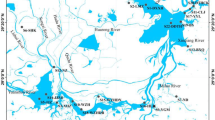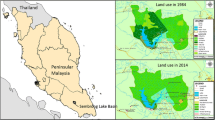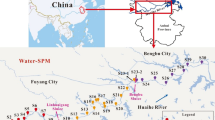Abstract
Organochlorine pesticides (OCPs), a potential threat to ecosystems and human health, are still widely residual in the environment. The residual levels of OCPs in the water and gas phase were monitored in Lake Chaohu, a large Chinese lake, from March 2010 to February 2011. Nineteen types of OCPs were detected in the water with a total concentration of 7.27 ± 3.32 ng/l. Aldrin, DDTs and HCHs were the major OCPs in the water, accounting for 38.3 %, 28.9 % and 23.6 % of the total, respectively. The highest mean concentration (12.32 ng/l) in the water was found in September, while the lowest (1.74 ng/l) was found in November. Twenty types of gaseous OCPs were detected in the atmosphere with a total concentration of 542.0 ± 636.5 pg/m3. Endosulfan, DDTs and chlordane were the major gaseous OCPs in the atmosphere, accounting for 48.9 %, 22.5 % and 14.4 % of the total, respectively. The mean concentration of gaseous OCPs was significantly higher in summer than in winter. o,p′-DDE was the main metabolite of DDT in both the water and gas phase. Of the HCHs, 52.3 % existed as β-HCH in the water, while α-HCH (37.9 %) and γ-HCH (30.9 %) were dominant isomers in the gas phase. The average fluxes were −21.11, −3.30, −152.41, −35.50 and −1314.15 ng/(m2 day) for α-HCH, γ-HCH, HCB, DDT and DDE, respectively. The water–gas exchanges of the five types of OCPs indicate that water was the main potential source of gaseous OCPs in the atmosphere. A sensitivity analysis indicated that the water-gas flux of α-HCH, γ-HCH and DDT is more vulnerable than that of HCB and DDE to the variation of the parameters. The possible source of the HCHs in the water was from the historical usage of lindane; however, that in the air was mainly from the recent usage of lindane. The technical DDT and dicofol might be the source of DDTs in the water and air.







Similar content being viewed by others
References
Aaron TF, Gary AS, Kerth AH et al (2001) Persistent organic pollutants (POPs) in a small, herbivorous, arctic marine zooplankton (Calanus hyperboreus): trends from April to July and the influence of lipids and trophic Transfer. Mar Pollut Bull 43(1–6):93–101
Alegria HA, Bidleman TF, Shaw TJ (2000) Organochlorine pesticides in ambient air of Belize, Central America. Environ Sci Technol 34(10):1953–1958
Alegria H, Bidleman TF, Figueroa MS (2006) Organochlorine pesticides in the ambient air of Chiapas, Mexico. Environ Pollut 140(3):483–491
Carrera G, Fernández P, Vilanova RM et al (2001) Persistent organic pollutants in snow from European high mountain areas. Atmos Environ 35(2):245–254
Chernyak SM, McConnell LL, Riee CP (1995) Fate of some chlorinated hydrocarbons in arctic and far eastern ecosystems in the Russian Federation. Sci Total Environ 160–161:75–85
Colborn T, Dumanoski D, Myers JP (1996) Our stolen future. Dutton, New York
Cotham WE, Bidleman TF (1991) Estimating the deposition of organochlorine contaminants to the Arctic. Chemosphere 22(1–2):165–188
de Joode BW, Wesseling C, Kromhout H et al (2001) Chronic nervous-system effects of long-term occupational exposure to DDT. Lancet 357(9261):1014–1016
Fernandez MA, Alonso C, Gonzalez MI et al (1999) Occurrence of organochlorine insecticides, PCBs and PCB congeners in water and sediments of the Ebro River (Spain). Chemosphere 38(1):33–43
Harner T, Wiberg K, Norstrom R (2000) Enantiomer fractions are preferred to enantiomer ratios for describing chiral signatures in environmental analysis. Environ Sci Technol 34(1):218–220
Hu GC, Luo XJ, Li FC et al (2010) Organochlorine compounds and polycyclic aromatic hydrocarbons in surface sediment from Baiyangdian Lake, North China: concentrations, sources profiles and potential risk. J Environ Sci 22(2):176–183
Iwata H, Tanabe S, Tatsukawa R (1993) A new view on the divergence of HCH isomer compositions in oceanic air. Mar Pollut Bull 26:302–305
Iwata H, Tanabe S, Ueda K, Tatsukawa R (1995) Persistent organochlorine residues in air, water, sediments, and soils from the Lake Baikal region. Russ Environ Sci Technol 29:792–801
Jantunen LMM, Bidleman TF, Harner T et al (2000) Toxaphene, chlordane, and other organochlorine pesticides in Alabama air. Environ Sci Technol 34(24):5097–5105
Jiang X, Xu SF, Martens D et al (2000) Polychlorinated organic contaminants in waters, suspended solids and sediments of the Nanjing section, Yangtze River. China Environ Sci 20(3):193–197
Kang Y-H, Liu P-B, Wang Z-J et al (2003) Persistent organochlorine pesticides in water from Guanting Reservoir and Yongdinghe River, Beijing. J Lake Sci 15(2):125–132 (in Chinese)
Kannan K, Tanabe S, Tatsukawa R (1995) Geographical distribution and accumulation features of organochlorine residues in fish of tropical Asia and Oceania. Environ Sci Technol 29(10):2673–2683
Liu M (2005a) Environmental biogeochemical process and ecological risk of POPs in Chaotan, Yangtze River. China Environmental Science Press, Beijing
Liu Z-T (2005b) Environmental behavior characteristics and research progress of persistent organic pollutants. Res Environ Sci 18(3):93–102 (in Chinese)
Maskaoui K, Zhou JL, Zheng TL et al (2005) Organochlorine micropollutants in the Jiulong River Estuary and Western Xiamen Sea, China. Mar Pollut Bull 51(8–12):950–959
Murayama H, Takase Y, Mitobe H et al (2003) Seasonal change of persistent organic pollutant concentrations in air at Niigata area, Japan. Chemosphere 52(4):683–694
Ouyang HL, He W, Qin N, Kong XZ, Liu WX, He QS, Jiang YJ, Wang QM, Yang C, Yang B, Xu FL (2012) Levels, temporal–spatial variations and sources of organochlorine pesticides in ambient air of Lake Chaohu, China. The Scientific World Journal. doi:10.1100/2012/504576
Qiu XH, Zhu T, Jing L, Pan HS, Li QL, Miao GF, Gong JC (2004) Organochlorine pesticides in the air around the Taihu Lake, China. Environ Sci Technol 38(5):1368–1374
Shao D-D, Shi S-T, Zhou L et al (2007) A survey of atmosphere organochlorine pesticides residual levels in four provinces along the Yangtze River. Environ Prot 386(12B):68–69 (in Chinese)
Shen L, Wania F, Lei YD et al (2004) Hexachlorocyclohexanes in the North American atmosphere. Environ Sci Technol 38(4):965–975
Singh KP, Malik A, Mohan D et al (2005) Distribution of persistent organochlorine pesticide residues in Gomti River, India. Bull Environ Contam Toxicol 74:146–154
Tang ZW, Yang ZF, Shen ZY et al (2008) Residues of organochlorine pesticides in water and suspended particulate matter from the Yangtze River catchment of Wuhan, China. Environ Monit Assess 137:427–439
Tian G, Chen Y-Q, Wan X-Z et al (2010) Investigations and control measures on seven persistent organic pollutants in protected region of drinking water sources of Xiangjiang in Changsha. Environ Monit China 26(1):58–62 (in Chinese)
Turgut C (2003) The contamination with organochlorine pesticides and heavy metals in surface water in Küçük Menderes River in Turkey, 2000–2002. Environ Int 29(1):29–32
UNEP (2004) Regional Based Assessment of Persistent Toxic Substances: Global Report 2003. http://www.chem.unep.ch/pts/gr/Global_Report.pdf
USEPA (1999) Compendium method TO-13A, Determination of polycyclic aromatic hydrocarbons (PAHs) in ambient air using gas chromatography/mass spectrometry (GC/MS). http://www.epa.gov/ttnamti1/files/ambient/airtox/to-13arr.pdf
Wan YW, Kang TF, Zhou ZL (2009) Health risk assessment of volatile organic compounds in water of Beijing Guanting Reservoir. Res Environ Sci 22(2):150–154 (in Chinese)
Wang XT, Chu SG, Xu XB (2003) Organochlorine pesticide residues in water from Guanting Reservoir and Yongding River, China. Bull Environ Contam Toxicol 70:351–358
Wang Y, Wu WJ, He W, Qin N, He QS, Xu FL (2012) Residues and ecological risks of organochlorine pesticides in Lake Small Baiyangdian, North China. Environ Monit Assess. doi:10.1007/s10661-012-2601-5
Wei LL, Guo F, Wang JZ et al (2011) Distribution characteristics of organochlorine pesticides in karst subterranean river in Liuzhou. Carsol Sin 30:16–21
WHO (1989) Environmental Health Criteria for DDT and its derivatives, environmental aspects. World Health Organization, Geneva. ISBN 92-4-154283-7
Willett KL, Ulrich EM, Hites RA (1998) Differential toxicity and environmental fates of hexachlorocyclohexane isomers. Environ Sci Technol 32(15):2197–2207
Wu XG, Lam JCW, Xia CH et al (2011) Atmospheric concentrations of DDTs and chlordanes measured from Shanghai, China to the Arctic Ocean during the Third China Arctic Research Expedition in 2008. Atmos Environ 45(22):3750–3757
Xia F, Hu X-X, Han Z-H et al (2006) Distribution characteristic s of organochlorine pesticides in surface water from the Huangpu River. Res Environ Sci 19(2):11–15 (in Chinese)
Yang Q-S, Mai B-X, Fu J-M et al (2004) Spatial and temporal distribution of organochlorine pesticides (OCPs) in surface water from the Pearl River artery estuary. Environ Sci 25(2):150–156 (in Chinese)
Yu Y-J, Huang H, Wang B et al (2004) Level of organochlorine pesticide pollution in the water of the Huaihe River, Jiangsu province. Environ Chem 23(5):568–572 (in Chinese)
Zhang W-L, Zhang G, Qi S-H et al (2003) A preliminary study of organochlorine pesticides in water and sediments from two Tibetan lakes. Geochimica 32(4):363–367 (in Chinese)
Zhao L, Hou H, Zhou YY et al (2010) Distribution and ecological risk of polychlorinated biphenyls and organochlorine pesticides in surficial sediments from Haihe River and Haihe Estuary Area, China. Chemosphere 78(10):1285–1293
Zhi X, Niu J-F, Tang Z-W et al (2008) Ecological risk assessment of typical organochlorine pesticides in water from the Wuhan reaches of the Yangtze River. Acta Sci Circumstantiae 28(1):168–173 (in Chinese)
Zhou RB, Zhu LZ, Chen YY (2008) Levels and source of organochlorine pesticides in surface waters of Qiantang River, China. Environ Monit Assess 136:277–287
Acknowledgments
Funding for this study was provided by the National Foundation for Distinguished Young Scholars (40725004), the Key Project of the National Science Foundation of China (NSFC) (41030529), the National Project for Water Pollution Control (2012ZX07103-002), the Ministry of Environmental Protection (201009032) and the Ministry of Education (20100001110035).
Author information
Authors and Affiliations
Corresponding author
Additional information
Responsible editor: Gerhard Lammel
Hui-Ling Ouyang and Wei He are the first co-authors.
Rights and permissions
About this article
Cite this article
Ouyang, HL., He, W., Qin, N. et al. Water–gas exchange of organochlorine pesticides at Lake Chaohu, a large Chinese lake. Environ Sci Pollut Res 20, 2020–2032 (2013). https://doi.org/10.1007/s11356-012-1374-2
Received:
Accepted:
Published:
Issue Date:
DOI: https://doi.org/10.1007/s11356-012-1374-2




